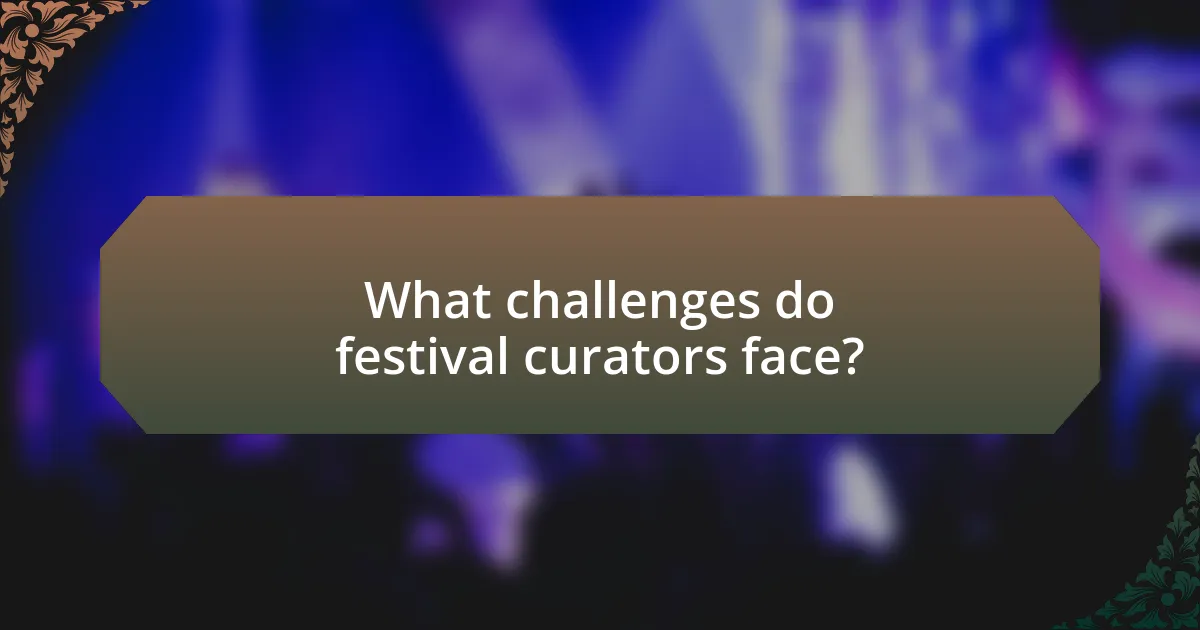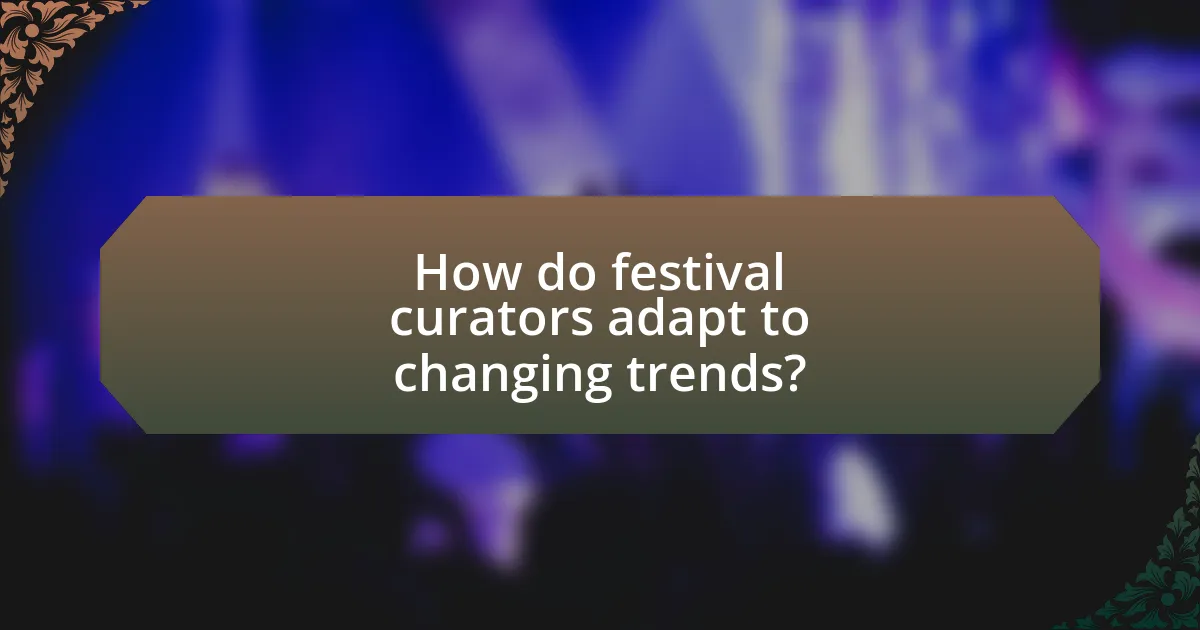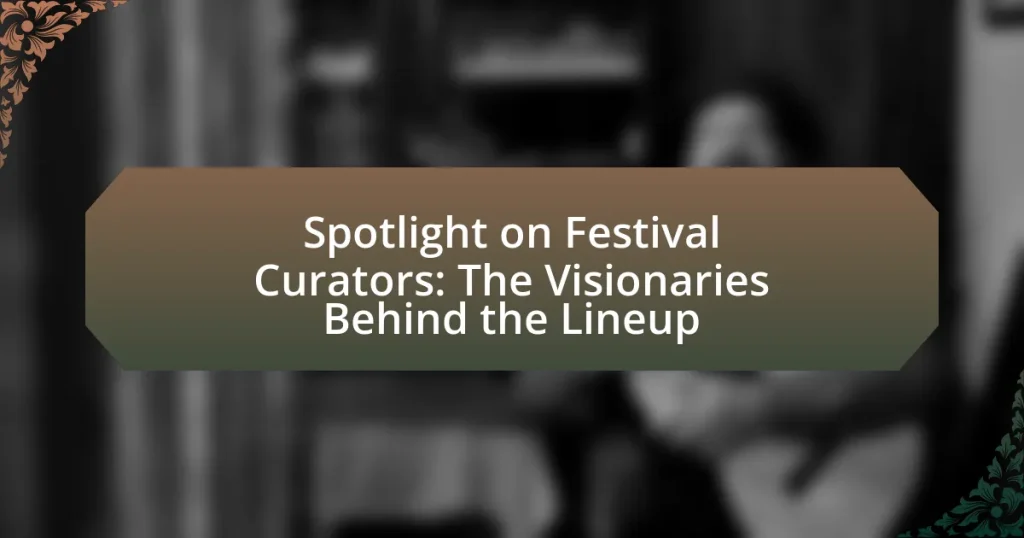Festival curators are pivotal figures in shaping the lineups of music and arts festivals, as they select artists and performances that align with the festival’s vision and theme. Their role involves analyzing trends, audience preferences, and cultural significance to create diverse and engaging experiences. Curators balance emerging talent with established artists, evaluate potential acts based on artistic quality and audience appeal, and navigate challenges such as budget constraints and artist availability. They also adapt to changing trends, incorporating diversity, sustainability, and technology into their selections, while fostering collaborations that enhance the overall festival experience. This article explores the multifaceted responsibilities of festival curators and their impact on audience engagement and cultural trends.

What is the role of festival curators in shaping lineups?
Festival curators play a crucial role in shaping lineups by selecting artists and acts that align with the festival’s vision and theme. They analyze current trends, audience preferences, and the cultural significance of performers to create a cohesive and engaging experience. For instance, curators often prioritize diversity and representation, ensuring that various genres and backgrounds are included, which can enhance the festival’s appeal and reach. Their decisions directly impact ticket sales and audience satisfaction, as a well-curated lineup can attract larger crowds and foster a memorable atmosphere.
How do festival curators select artists and performances?
Festival curators select artists and performances through a combination of artistic vision, audience appeal, and logistical considerations. They evaluate submissions, consider past performances, and assess the relevance of artists to the festival’s theme or mission. Curators often prioritize diversity in genres and styles to create a well-rounded lineup that attracts a broad audience. Additionally, they may rely on industry connections and recommendations to identify emerging talent. This selection process is supported by data on audience preferences and ticket sales from previous events, ensuring that the chosen artists resonate with festival-goers.
What criteria do curators use to evaluate potential acts?
Curators evaluate potential acts based on several key criteria, including artistic quality, audience appeal, and logistical feasibility. Artistic quality involves assessing the originality, creativity, and technical skill of the act, ensuring it aligns with the festival’s vision and theme. Audience appeal considers the act’s popularity and ability to engage the target demographic, which is crucial for ticket sales and overall festival success. Logistical feasibility encompasses factors such as the act’s availability, technical requirements, and budget constraints, ensuring that the act can be effectively integrated into the festival schedule. These criteria help curators create a diverse and compelling lineup that resonates with attendees and enhances the festival experience.
How do curators balance emerging talent with established artists?
Curators balance emerging talent with established artists by strategically integrating both groups into their programming to create a diverse and engaging lineup. This approach allows curators to showcase innovative works from new artists while also drawing audiences with the recognition and experience of established figures. For instance, festivals often allocate specific slots for emerging artists, ensuring they receive visibility alongside well-known acts, which can enhance the overall festival experience and foster new talent development. This method not only supports the growth of emerging artists but also revitalizes the established artists’ relevance by placing them in a dynamic context.
Why are festival curators considered visionaries?
Festival curators are considered visionaries because they possess the ability to foresee and shape cultural trends through their unique programming choices. Their expertise allows them to identify emerging artists and innovative concepts that resonate with audiences, creating memorable experiences that reflect the zeitgeist. For instance, curators like David Byrne have successfully integrated diverse genres and art forms, pushing the boundaries of traditional festival lineups and fostering a sense of community. This forward-thinking approach not only enhances the festival’s appeal but also influences the broader cultural landscape, establishing curators as key figures in the evolution of the arts.
What impact do curators have on the festival’s overall theme?
Curators significantly shape the festival’s overall theme by selecting artists and works that align with a specific vision or concept. Their choices influence the narrative and emotional tone of the festival, creating a cohesive experience for attendees. For instance, a curator may focus on themes of social justice, which can lead to the inclusion of performances and installations that provoke thought and discussion around that topic. This intentional curation not only enhances the festival’s identity but also engages the audience in a deeper exploration of the chosen theme, as evidenced by festivals like the Venice Biennale, where curatorial themes drive the artistic direction and public discourse.
How do curators influence audience experience and engagement?
Curators influence audience experience and engagement by carefully selecting and organizing content that resonates with the audience’s interests and expectations. Their choices shape the thematic coherence of exhibitions or festivals, enhancing emotional connections and fostering a sense of community among attendees. For instance, a study by the American Alliance of Museums found that well-curated exhibits can increase visitor satisfaction by up to 40%, demonstrating the significant impact of curatorial decisions on audience engagement.

What challenges do festival curators face?
Festival curators face several challenges, including budget constraints, artist availability, and audience engagement. Budget constraints limit the ability to book high-profile acts or invest in production quality, which can affect the overall festival experience. Artist availability is often a significant hurdle, as popular performers may have conflicting schedules or high fees, making it difficult to secure a desirable lineup. Additionally, engaging the audience is crucial; curators must balance diverse programming that appeals to various demographics while ensuring that the festival remains cohesive and true to its vision. These challenges require strategic planning and adaptability to create a successful festival.
How do curators navigate budget constraints?
Curators navigate budget constraints by prioritizing essential programming and seeking alternative funding sources. They often assess the festival’s goals and audience needs to allocate resources effectively, ensuring that key performances and installations are funded first. Additionally, curators may collaborate with sponsors, apply for grants, and engage in community partnerships to supplement their budgets. For instance, a study by the National Endowment for the Arts highlights that festivals that diversify funding sources can increase their financial stability, allowing curators to maintain high-quality programming despite budget limitations.
What strategies do curators use to maximize limited resources?
Curators maximize limited resources by prioritizing partnerships and collaborations. By forming alliances with local artists, organizations, and sponsors, curators can share costs and access a wider range of resources. For instance, many festivals leverage community support to reduce expenses related to venue and logistics, allowing them to allocate funds more effectively. Additionally, curators often utilize digital platforms for promotion and ticket sales, which can significantly lower marketing costs compared to traditional methods. This strategic approach not only enhances resource efficiency but also fosters community engagement and support for the festival.
How do curators handle artist cancellations or changes?
Curators manage artist cancellations or changes by implementing contingency plans and maintaining open communication with both artists and stakeholders. They often have backup artists or alternative programming ready to ensure the festival’s schedule remains intact. For instance, curators may have a list of potential replacements or adjust the lineup to accommodate the changes, thereby minimizing disruption. This proactive approach is essential in the fast-paced environment of festival planning, where last-minute changes can occur due to various reasons such as scheduling conflicts or unforeseen circumstances.
What role does collaboration play in the curation process?
Collaboration is essential in the curation process as it enhances the diversity and quality of the curated content. By working together, curators can pool their expertise, share resources, and incorporate multiple perspectives, which leads to a more comprehensive and engaging lineup. For instance, festival curators often collaborate with artists, industry professionals, and community members to ensure that the selection reflects a wide range of voices and styles, ultimately enriching the audience’s experience. This collaborative approach is supported by research indicating that diverse teams produce more innovative outcomes, as seen in studies on group dynamics and creativity in artistic settings.
How do curators work with promoters and sponsors?
Curators collaborate with promoters and sponsors by aligning artistic vision with marketing strategies and funding opportunities. This partnership involves curators selecting artists and performances that resonate with the festival’s theme while promoters handle logistics and audience engagement. Sponsors provide financial support, which curators leverage to enhance the festival experience, ensuring that the selected acts can be showcased effectively. For instance, a curator may work with a sponsor to create a branded stage that highlights specific performances, thereby increasing visibility for both the artists and the sponsor. This synergy ultimately aims to create a cohesive festival experience that attracts attendees and meets the objectives of all parties involved.
What partnerships are essential for successful festival curation?
Successful festival curation relies on partnerships with artists, sponsors, local businesses, and community organizations. Collaborating with artists ensures a diverse and appealing lineup, while sponsors provide essential funding and resources. Local businesses contribute to the festival’s infrastructure and logistics, enhancing the overall experience. Community organizations help in outreach and engagement, fostering a sense of belonging and support. These partnerships create a synergistic environment that enhances the festival’s success and sustainability.

How do festival curators adapt to changing trends?
Festival curators adapt to changing trends by continuously analyzing audience preferences and industry developments. They utilize data from ticket sales, social media engagement, and cultural shifts to inform their programming decisions. For instance, the rise of electronic music in the past decade has led many curators to incorporate more electronic acts into their lineups, reflecting audience demand. Additionally, curators often attend other festivals and industry events to observe emerging trends and network with artists, ensuring they remain relevant and innovative in their selections. This proactive approach allows them to create diverse and appealing festival experiences that resonate with contemporary audiences.
What current trends are influencing festival lineups?
Current trends influencing festival lineups include a focus on diversity, sustainability, and the integration of technology. Festivals are increasingly prioritizing diverse lineups that represent various genres, genders, and cultural backgrounds, reflecting a broader societal push for inclusivity. Additionally, sustainability practices are becoming essential, with many festivals committing to eco-friendly initiatives, such as reducing waste and promoting local artists. The integration of technology, including virtual reality experiences and live streaming, is also shaping how festivals curate their lineups, allowing for greater audience engagement and accessibility. These trends are supported by industry reports indicating that audiences are more likely to attend festivals that align with their values on diversity and sustainability.
How do curators incorporate diversity and inclusivity in their selections?
Curators incorporate diversity and inclusivity in their selections by actively seeking out artists and works that represent a wide range of cultural, social, and demographic backgrounds. This approach often involves researching underrepresented communities and prioritizing voices that have historically been marginalized in the arts. For instance, curators may analyze demographic data to ensure that their selections reflect the diversity of the audience and the broader society, thereby fostering a more inclusive environment. Additionally, initiatives such as community engagement programs and partnerships with diverse organizations can further enhance the representation of varied perspectives in their selections.
What technological advancements are impacting curation practices?
Technological advancements such as artificial intelligence, machine learning, and data analytics are significantly impacting curation practices. These technologies enable curators to analyze vast amounts of data to identify trends, audience preferences, and emerging artists, thereby enhancing the selection process for festivals. For instance, AI algorithms can predict which acts are likely to attract larger audiences based on historical data and social media engagement, leading to more informed decisions in lineup creation. Additionally, platforms that utilize data analytics provide insights into ticket sales and demographic information, allowing curators to tailor their selections to specific audience segments, ultimately improving the overall festival experience.
What best practices can aspiring curators learn from established professionals?
Aspiring curators can learn several best practices from established professionals, including the importance of building strong relationships within the industry, understanding audience engagement, and maintaining a clear vision for their projects. Established curators often emphasize networking as a key component, as connections with artists, sponsors, and other stakeholders can lead to successful collaborations and opportunities. Additionally, they highlight the necessity of audience research to tailor programming that resonates with specific demographics, ensuring higher attendance and satisfaction. Furthermore, a well-defined vision helps curators to create cohesive and impactful experiences, as seen in successful festivals that consistently attract large crowds and critical acclaim.
How can new curators build their networks and gain experience?
New curators can build their networks and gain experience by actively participating in industry events, collaborating with established professionals, and utilizing social media platforms. Engaging in festivals, workshops, and conferences allows curators to meet peers and industry leaders, fostering valuable connections. Collaborating on projects with experienced curators provides hands-on experience and mentorship opportunities. Additionally, platforms like Instagram and LinkedIn enable curators to showcase their work, connect with other professionals, and stay informed about industry trends, which is essential for career growth.
What resources are available for curators to enhance their skills?
Curators can enhance their skills through various resources, including professional development programs, workshops, online courses, and industry conferences. For instance, organizations like the American Alliance of Museums offer training sessions that focus on curation and exhibition design. Additionally, platforms such as Coursera and edX provide online courses on topics relevant to curatorial practices, including art history and museum management. Conferences like the Museums Association Annual Conference facilitate networking and knowledge sharing among curators, allowing them to learn from peers and industry leaders. These resources collectively support curators in developing their expertise and staying updated with industry trends.
